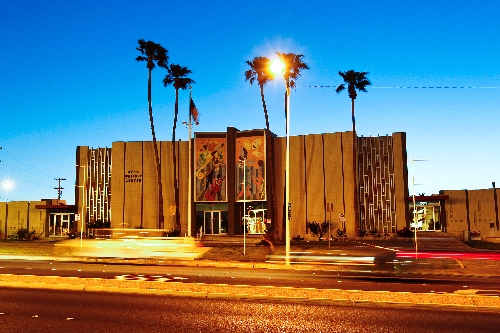Reed Whipple Cultural Arts Center’s namesake was a champion for downtown

Reed Whipple might have his name on the side of a downtown Las Vegas building for only a few more months.
Whipple is the namesake for the Reed Whipple Cultural Center, 821 Las Vegas Blvd. North , which used to be a church administrative building that combined a stake center and a multipurpose recreational facility, according to “The First 100: Portraits of the Men and Women Who Shaped Las Vegas.”
The cultural center was opened by the LDS Church in September 1963. The project cost about $600,000. The facility was then sold to the city in 1970 for $1,067,000 and housed the Las Vegas municipality until City Hall, 400 Stewart Ave., was completed in late 1972. The cultural center was remodeled and opened as it stands today. It houses a 275-seat multi purpose theater , an 80-seat studio theater , an art gallery, a dance studio, a conference room, a meeting room, a pottery studio and a kitchen.
However, the center’s fate is expected to change soon.
In March, Las Vegas city officials recommended closing the facility to help deal with a $70 million shortfall expected in the next fiscal year. The proposed closure would be included in $31 million worth of budget cuts to help the city stay afloat during the economic downturn.
At this time, it is unknown who would take over the building, city officials said.
“The Request for Proposals for Reed Whipple Cultural Center is still open, and no decision has been made as to the disposition of the property,” wrote Margaret Kurtz, city publicity specialist, in an email. “At this time, there is no way to know whether the center will continue to bear the Reed Whipple name after a proposal is accepted.”
One group that has expressed interest in acquiring the property is the Las Vegas Shakespeare Company. Calls to the company were not returned.
The facility was dedicated in Whipple’s honor on Feb. 16, 1971, by former Las Vegas Mayor Oran Gragson in tribute for Whipple’s services to the city of Las Vegas. Whipple, who served more than 20 years on the city commission (now known as the Las Vegas City Council), was quiet and religious, serving as Bishop of the First Ward of the Church of Jesus Christ of Latter-day Saints.
According to the city’s website, Las Vegas operated under a “commission” form of government with each commissioner having administrative control over certain operating departments of the city. Since 1944, the city has operated under a “council/manager” form of government.
Whipple is credited with conceiving the idea for municipal parking garages downtown to handle the city’s congested streets. He also was instrumental in negotiating the deal for the Foley Federal Building to be located at 300 Las Vegas Blvd. South , near Bridger Street.
“(Whipple) was a straight, no-nonsense person, and I don’t think he had any interests other than serving the people and city of Las Vegas,” Gragson said in an interview with the “First 100” authors. “When I was first elected ( in 1959 ), I relied on his counsel in many matters.”
Whipple graduated from the old Clark County High School after he moved to the Las Vegas Valley at age 17. He worked for the Union Pacific Railroad before becoming a bookkeeper at First State Bank in 1926. The bank became First National Bank, and it was where Whipple worked until he retired in 1970 as vice president.
He died in 1986 at age 81.
Contact Downtown and North Las Vegas View reporter Kristi Jourdan at kjourdan@viewnews.com or 383-0492.












